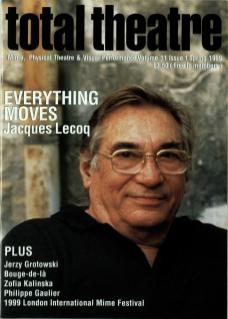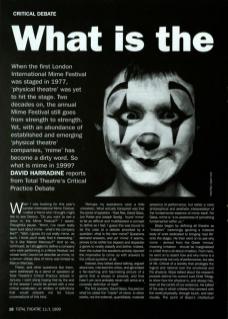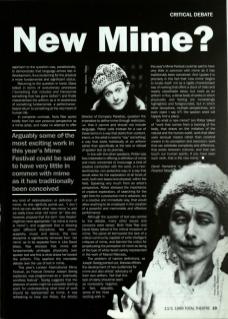When I was booking for this year's London International Mime Festival, I called a friend who I thought might like to see Derevo. ‘Do you want to see a show in the Mime Festival?’ I asked. Thoughtful pause. ‘Hmm, I've never really been sure about mime – what's the company like?’ ‘Well, I guess it's not really mime, as such. I think you'll really find it interesting.’ ‘Is it like Marcel Marceau?’ And so we continued; as I struggled to define a company who were performing in a Mime Festival, but whose work I would not describe as mime, to a person whose idea of mime was limited to Marcel Marceau.
These, and other questions like them, were addressed by a panel of speakers at Total Theatre's Critical Practice debate in January. I went along hoping that by the end of the session I would be armed with a new critical vocabulary – an artillery of definitions that would prepare me for future conversations of this kind.
Perhaps my aspirations were a little unrealistic. What actually transpired was that the panel of speakers – Nola Rae, David Glass, Jon Potter and Joseph Seelig – found 'mime’ to be as difficult and multifaceted a concept to define as I had. I guess this was bound to be the case at a debate provoked by a question: what is the new mime? Questions demand answers, and yet ‘mime', it seems, proves to be rather too slippery and disparate a genre to neatly classify and define. Indeed, from the outset the speakers actively rejected the imperative to come up with answers to the critical question at all.
Instead, they talked about talking, argued about text, criticised the critics, and generated a far-reaching and fascinating picture of a genre that is always in process, and that hasn't yet (and probably never will) arrive at a concrete definition of itself.
The first speaker, David Glass, focused on what he called the ‘inside’ of mime. In other words, not the external, quantifiable, material presence of performance, but rather a more philosophical and aesthetic interpretation of the fundamental essence of mime itself. For Glass, mime is ‘a re-awareness of something fundamental within us’.
Glass began by defining all theatre as ‘imitation’ (seemingly ignoring a massive body of work dedicated to bringing real life onto the stage). He then went on to ask why mime – derived from the Greek 'mimus’ meaning imitation – should be marginalised in a field that is all about imitation. From here, he went on to assert how and why mime is a fundamental not only of performance, but also of life. Critical of a society that privileges the logical and rational over the emotional and the physical, Glass talked about the research process behind his current Lost Child Trilogy to show how the physical is, and always has, been at the centre of our existence. He talked of the way in which children first connect with the world physically, through touch, and later visually. The point of Glass' intellectual approach to the question was, paradoxically, to demonstrate that language arrives late in development, thus reclaiming for the physical a more fundamental and significant status.
Returning to the question in hand, Glass talked in terms of evolutionary processes (‘something that includes and transcends something that has gone before’) and finally characterised the artform as a re-awareness of something fundamental, a performance-based return to something at the very heart of human life.
In complete contrast, Nola Rae spoke briefly from her own personal perspective as a mime artist, and made no attempt to offer any kind of rationalisation or definition of mime. As she rightfully points out, ‘I don't think we can decide what “new mime” is until we really know what “old mime” is!’ She did, however, propose that the term 'new theatre’ might be more appropriate (‘as mime is mime is mime’), and suggested that in drawing upon different disciplines, like clown, puppetry, music and dance, this new discipline is significantly removed from 'old mime' as to be separate from it. Like David Glass, Rae stresses that mime still fundamentally privileges physicality over spoken text and this is what draws her toward the artform. This sparked the inevitable debate over the use of text in mime.
This year's London International Mime Festival, as Festival Director Joseph Seelig explained, was programmed as a ‘practically wordless festival’. Seelig suggests that the absence of words might be a possible starting point for understanding what kind of work should be represented as mime. It was refreshing to hear Jon Potter, the Artistic Director of Company Paradiso, question the imperative to define mime through restriction, i.e. that it cannot and should not include language. Potter calls instead for a use of these terms in a way that starts from content, intent, or the artist's need to say something in a way that looks holistically at an artform rather than specifically at the lack or refusal of spoken text as its premise.
Arguably some of the most exciting work in this year's Mime Festival could be said to have very little in common with mime as it has traditionally been conceived
In line with the other speakers, Potter was less interested in offering a definition of mime and more concerned to encourage a kind of creative connection with the word, in a non-sentimental, non-protective way, in a way that would allow for the exploration of all kinds of work, both text-based and physical, within the field. Speaking very much from an artist's perspective, Potter stressed the importance of creative exploration, of searching for the right form for a production not in advance, but in a creative and immediate way, that would allow anything to be employed in the creation of a powerful and memorable and effective performance.
Although the question of text was central to the debate, many other issues and concerns were raised. Both Nola Rae and David Glass talked of the critical reception of mime. The panel all bemoaned the lack of a critical community capable of write intelligent critiques of mime, and blamed the critics for perpetuating the perception of mime as being of the type of white-faced variety represented in the work of Marcel Marceau.
The problem of narrow definitions, as Joseph Seelig pointed out, likewise effects the development of new audiences for mime and also artists' advocacy of their own artform. Not that this lack of clarity should be seen as necessarily negative. In fact, arguably some of the most exciting work in this year's Mime Festival could be said to have very little in common with mime as it has traditionally been conceived. And I guess it is precisely in this fact that 'new mime' begins to locate itself: not as a rigidly characterised way of working that offers a stock of traits and readily classifiable ideas, but more as an artform in flux, a literal body of works in which physicality and feeling are increasingly highlighted and foregrounded, but in which other disciplines, multiple perspectives, and even (dare I say it?) the spoken word will happily find a place.
So what is new mime? Jon Potter talked of ‘work that comes from a training of the body, that draws on the imitation of the natural and the human world, work that often uses sensual means rather than cerebral means in its conception and execution; work that can celebrate complexity and difference, that exists between cultures, and that can touch our human spirits. If you have seen such work, that is the new mime.’
David Harradine is artistic director of Fevered Sleep.


